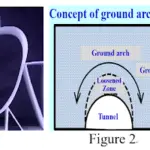Saad Iqbal | 🗓️Modified: September 29, 2016 | ⏳Read Time: 3 min | 👁Post Views: 129
Marshall Stability and Flow Test is basically one portion of the Marshall Mix Design process beside Void ratios and Density calculations as other processes. Marshall Stability Test gives an idea about the sustainability and strength of the asphalt mix of various proportions under the dynamic loading of the traffic.
As per the standard procedure for the Marshall Stability test, the sample is first prepared having specific amount of aggregate of specific gradation along with some suitable amount of bitumen or binder content as stated here
The marshall stability and test provides the performance prediction measures for the Marshall Mix Design Method.
Marshall Stability and flow values along with density, air voids in the total mix, voids in mineral aggregates or voids filled with asphalt or both filled with asphalt are used for laboratory mix design and evaluation of asphalt mixtures. In addition, Marshall Stability and flow can be used to monitor the plant process of producing asphalt mixtures. Marshall Stability and flow may also be used to relatively evaluate different mixes and the effect of conditioning such as with water.
 |
| Marshall Stability Apparatus |
The Marshall Stability and flow test results are applicable to dense-graded asphalt mixtures with maximum size aggregate upto 1 in. in size. For the purpose of mix design, Marshall Stability and flow test results should consist of the average of a minimum of three specimens at each increment of binder content range is generally selected on the basis of experience and historical testing data of the component materials, but may involve trial and error to include the desirable range of mix properties.
Stability, flow, density, air voids, and voids filled with asphalt binder, may be plotted against binder content to allow selection of an optimum binder content for the mixture.
After the preparation of the sample and determination of the properties mentioned above the Sample is taken for the Marshall Stability and Flow test.
Marshal Stability and Flow Test
After the sample preparation, the sample is extracted with the help of sample extractor as show :-
 |
| Marshall Sample Extractor |
The extracted sample is immersed in a bath of water at a temperature of 60 degree centigrade for a duration of 30 minutes. The sample is then placed in a Marshall Stability Testing Machine and loaded at a constant rate of deformation of 5 mm per minute until failure.
The Total Maximum load in kN that causes the failure of the specimen is taken as Marshall Stability. The stability value is also corrected for volume it will be explained later.
The Flow Value is also determined as :-
The total amount of deformation in units of 0.25 mm that occurs at maximum load is called flow value.
The total time between removing the specimen from the bath and completion of the test should not exceed 30 seconds.













